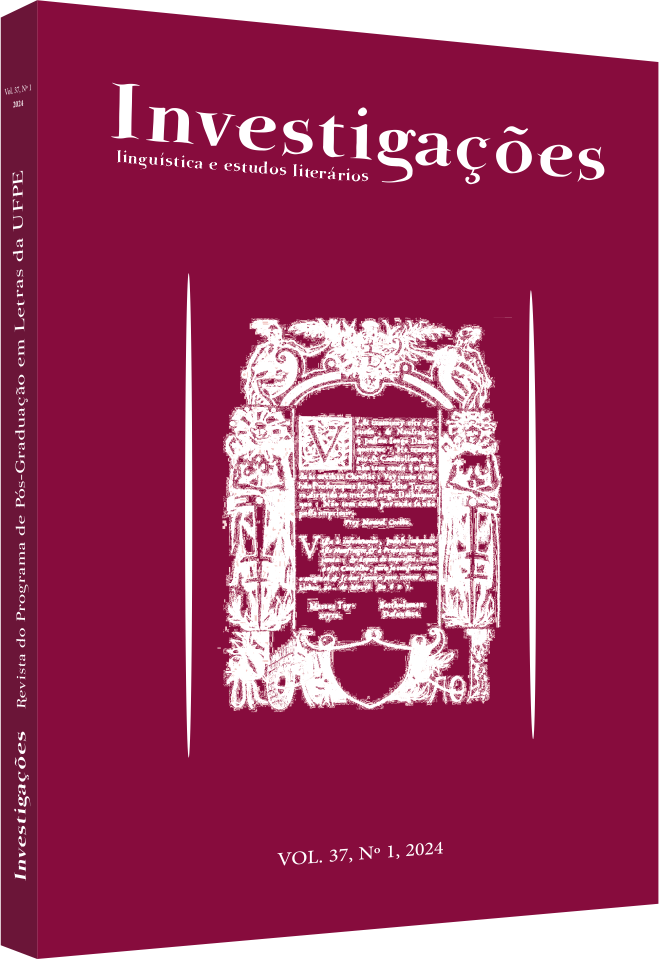The departure: towards the twelve mysteries of the Altarpiece of Santa Joana Carolina
DOI:
https://doi.org/10.51359/2175-294x.2024.258509Keywords:
dialectical criticism, post-modern brazilian literature, Osman LinsAbstract
This work analyzes the literary trajectory of the fiction writer Osman Lins (1924-1978) through the comparison between the short story “A Partida”, from Os gestos (1957), and the narrative “Retábulo de Santa Joana Carolina”, from Nove, novena (1966). Breaks and continuities are analyzed in his writing maturation process. It points out the permanence of the representation of the writer's grandmother, literarily transfigured in more and more complex forms. Astrological references are highlighted in the mentioned narrative, a resource based on an archaic mythological substrate. We seek to understand its formal innovation as an attempt to create a revolutionary art.
References
BASTIDE, Roger. O sagrado selvagem e outros ensaios. Tradução: Dorothée de Bruchard. São Paulo: Companhia das Letras, 2006.
BÍBLIA. Bíblia sagrada: edição pastoral. São Paulo: Paulus, 1991.
BOSI, Alfredo. História concisa da literatura brasileira. 2. ed. São Paulo: Cultrix, 1976.
CANDIDO, Antonio. A personagem do romance. In: CANDIDO, Antonio et al. (orgs). A personagem de ficção. 13. ed. São Paulo: Perspectiva, 2014. p. 51-80.
CERVANTES, Miguel de. O engenhoso fidalgo D. Quixote de Mancha – volume II. Tradução: José Luis Sánchez e Carlos Nougué. São Paulo: Abril, 2010.
CHEVALIER, Jean; GHEERBRANT, Alain. Dicionário de Símbolos. 14. ed. São Paulo: José Olympio, 1999.
EAGLETON, Terry. Marxismo e crítica literária. Porto: Afrontamento, 1976.
FRITOLI, Luiz Ernani. Os gestos de Osman Lins: um exercício de percepção do outro. Espaço Plural, Marechal Cândido Rondon, v. 7, n. 15, p. 15-17, jul./dez., 2006. Disponível em: https://www.redalyc.org/articulo.oa?id=445944366004. Acesso em 29 out. 2021.
GOMES, Leny da S. “Retábulo de Santa Joana Carolina”: uma conjunção de forças. In: HAZIN, Elizabeth; BARRETO, Francismar Ramírez; BONFIM, Maria Aracy (orgs.). Números e nomes: o júbilo de escrever. Brasília: Siglaviva, 2017. p. 125-150.
GUARNIERI, Ivanor Luiz. O engenho e os retábulos de Osman Lins. Tese (Doutorado em Teoria e Estudos Literários) – Programa de Pós-Graduação em Letras, Universidade Estadual Paulista “Júlio de Mesquita Filho”, São José do Rio Preto, 2016.
LINS, Osman. Lisbela e o prisioneiro. 3. ed. São Paulo: Planeta, 2015.
LINS, Osman. Marinheiro de primeira viagem. 2. ed. São Paulo: Summus, 1980.
LINS, Osman. O fiel e a pedra. São Paulo: Companhia das Letras, 2007.
LINS, Osman. Os gestos. 2. ed. São Paulo: Melhoramentos, 1975.
LINS, Osman. O visitante. 3. ed. São Paulo: Summus, 1979.
LINS, Osman. Retábulo de Santa Joana Carolina. In: LINS, Osman. Nove, novena. 4. ed. São Paulo: Companhia das Letras, 1994. p. 72-117.
PROENÇA FILHO, Domício. Estilos de época na literatura. 20. ed. São Paulo: Prumo, 2012.
ROCHA, Fernando A. D. O estatuto iconográfico do universo religioso de Osman no “Retábulo de Santa Joana Carolina”. In: GOMES, Leny e HAZIN, Elizabeth (orgs.). A escrita do mundo: letras, imagens e números (ensaios sobre a obra de Osman Lins). Porto Alegre: Metamorfose, 2016. p. 211-265.
ROSENFELD, Anatol. Os processos narrativos de Osman Lins. In: ROSENFELD, Anatol. Letras e leituras. São Paulo: Perspectiva, 1994. p. 163-180.
SISCAR, Marcos. A desconstrução de Jacques Derrida. In: BONNICI, Thomas e ZOLIN, Lúcia O. (orgs.). Teoria literária: abordagens históricas e tendências contemporâneas. 4. ed. Maringá: Eduem, 2019. p. 195-204.
STEEN, Edla van. Viver e escrever 2. 2. ed. Porto Alegre: L&PM, 2008.
TELES, Gilberto Mendonça. Vanguarda europeia e modernismo brasileiro: apresentação e crítica dos principais manifestos vanguardistas. 20. ed. Rio de Janeiro: José Olympio, 2012.
Downloads
Published
How to Cite
Issue
Section
License
Copyright (c) 2024 Mayara Moratori Peixoto

This work is licensed under a Creative Commons Attribution 4.0 International License.
Authors who publish with Revista Investigações agree to the following terms:
Authors retain copyright and grant the journal right of first publication with the work simultaneously licensed under the Creative Commons Attribution 4.0 International (CC BY 4.0) license that allows others to share the work with an acknowledgement of the work's authorship and initial publication in this journal.
Authors are able to enter into separate, additional contractual arrangements for the non-exclusive distribution of the journal's published version of the work (e.g., post it to an institutional repository or publish it in a book), with an acknowledgement of its initial publication in this journal.
You are free to:
Share — copy and redistribute the material in any medium or format for any purpose, even commercially.
Adapt — remix, transform, and build upon the material for any purpose, even commercially.
The licensor cannot revoke these freedoms as long as you follow the license terms.
Under the following terms:
Attribution — You must give appropriate credit , provide a link to the license, and indicate if changes were made . You may do so in any reasonable manner, but not in any way that suggests the licensor endorses you or your use.
No additional restrictions — You may not apply legal terms or technological measures that legally restrict others from doing anything the license permits.

